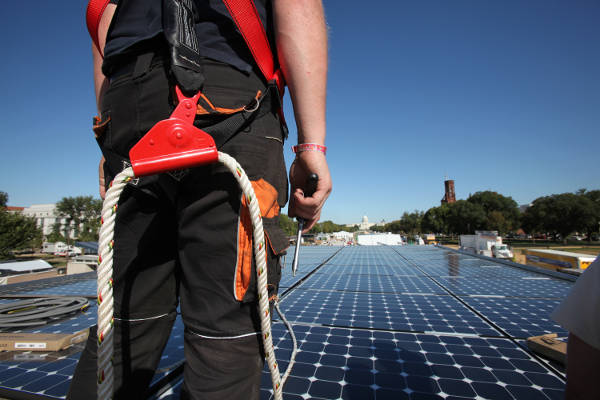Washington DC – Notwithstanding the coronavirus pandemic, renewable energy sources (i.e., biomass, geothermal, hydropower, solar, wind) continued to expand their share of the nation’s electricity production during the first three-quarters of 2020, according to a SUN DAY Campaign analysis of new data released by the U.S. Energy Information Administration (EIA).
The latest issue of EIA’s “Electric Power Monthly” (with data through September 30, 2020) reveals that solar and wind both showed continued, strong growth, expanding faster than all other energy sources.
For the period January – September, solar-generated electricity – including distributed solar – expanded by 22.1% (compared to the same period in 2019) and provided more than 3.4% of the nation’s total. Wind grew by 12.2% and accounted for 7.9% of total generation. Combined, net electrical generation by wind and solar was 15.0% greater than a year ago.
Electrical generation by geothermal energy and hydropower also increased – by 3.3% and 0.1% respectively – while that from biomass fell by 2.1%. Together with wind and solar, renewables provided 20.5% of total electrical output – up from 18.4% a year earlier.
Moreover, renewables’ share of U.S. electrical generation has eclipsed that of nuclear power (19.4%) and coal (18.6%). Renewables produced almost a tenth (i.e., 9.8%) more electricity than coal through September 2020. In fact, electrical generation by coal was 23.5% lower than a year earlier. In addition, renewable energy sources produced 5.2% more electricity than did nuclear power whose output fell 1.8% during the same nine-month period.
And in what may prove to be a harbinger of things to come, the increase in new electricity from wind and solar was greater than the increase in electrical generation by natural gas. That is, during the first three-quarters of 2020, solar and wind increased their electrical generation by 45,285 gigawatt-hours (GWh) compared to the same period in 2019. By comparison, electrical generation by natural gas increased by only 45,254 GWh. While it continued to provide the largest share (40.6%) of the nation’s electrical output, natural gas grew by only 3.8% during the first nine months of 2020 and actually dropped by 5.5% in the month of September.
“Notwithstanding the challenges posed by the coronavirus, renewable energy sources have continued expanding their share of the nation’s electrical generation,” noted the SUN DAY Campaign’s executive director Ken Bossong. “They have maintained their growing lead over nuclear power and coal and have begun to close the gap with natural gas.”
# # # # # # # # #
NOTE: The electricity figures cited above include EIA’s “estimated small-scale solar photovoltaic” (e.g., rooftop solar systems) which account for almost a third (31.7%) of total solar output and more than five percent (5.3%) of total net electrical generation by renewable energy sources.













Comments